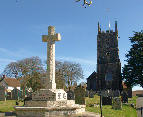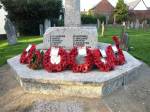George Robins was born in 1870, the youngest son of George and Mary Robins, who in 1871 were living in Lower Town in Winkleigh. George had one sister, Mary Ann, and two older brothers, William and Richard. Their father was a stone mason. In 1888 and aged 19 George, who had been working as a carpenter, decided to leave home and join the Coldstream Guards as a regular soldier. He joined up on 4th October 1909, signing up at the Devonshire Regimental depot in Exeter, where he also had his medical examination, described as ‘sallow in complexion’. George was mobilized into the 5th Batalion, the training battalion, before serving in either the first or second battalion, we do not know which. His period of service was originally 3 years with the colours, followed by 9 years in the Regimental Reserve.
George obviously enjoyed army life because he signed on again and eventually served 11 years and 121 days with the colours, and was discharged only on 28th October 1899, described as ‘medically unfit’. No sooner home, than George was married, to Alma Quiller, 13 years his senior and living in Vine Street, Winkleigh. Sadly, it was not a long marriage; Alma died in 1918 aged only 60.
During the first period of service in the Colstream Guards George had acquired not only a good conduct badge but also a third class educational grade: his previous education would have been limited to the early days of the Winkleigh Board School, and we do not know how far he had progressed. George described himself as a carpenter during this next period of his life.
With the outbreak of war on 4th August 1914, George was immediately summoned by the Coldstream Guards to return to service, under the terms of his service in the Reserve. He was now 44 years old: many men of this age would have found front line duties very hard indeed and many reserve men in various regiments were sooner or later transferred to Labour battalions for less arduous work behind the lines. George, however, proved the exception and his record is nearly unique in our Winkleigh story. Having re-enlisted on the very first day of the war, George lasted until the end, but without more military documents available his army service is somewhat of a mystery. Those documents that have survived were the ones copied to the Ministry of Pensions when he applies for a pension. The rest were lost in the blitz.
We do know that George was graded A1 at his medical held in the Devons’ depot in Exeter, and was enlisted immediately at the Chelsea barracks. He was posted on 14th August to the 2nd Battalion, Coldstream Guards, 4th Brigade, 2nd Division, 1st Corps, that arrived on France on that date, part of the original ‘old contemptables’ British Expeditionary Force under the command of Sir John French. This tiny army consisted of a mere 4 Infantry Divisions and 1 Cavalry Division, about 80,000 men, soon to be joined by a fifth Division of a further 17,000 men. Many of these men, moreover, particularly the Reservists, were often far from fit.
The 1st and 2nd Divisions formed the 1st Corps, under Sir Douglas Haig, but it was 2nd Corps that bore the brunt of the fighting at Mons, thus sparing George the worst of the initial combat, but of course involving him in the advance to Mons, the gruelling retreat, the advance to the Aisne and the transfer of the battalion to the Ypres sector. We are indebted to the Coldstream 2nd Battalion war diary to read a day by day account of the battalion’s movements since the first day of the war.
The battalion arrived at Le Havre on 13th August and was taken by train on the first stage of the journey, which took as long as three days to reach near the border. Then followed a long march, crossing the border at Malplaquet, and the battalion reaching Mons on the firing line at Harveng. They saw no Germans. It was Second Corps that fought the famous action at Mons: Haig had rejected a call from 2nd Corps for assistance and instead planned his own immediate retreat, with the Guards acting as the rearguard force. There was a very minor skirmish at the village of Landrecies but the 2nd Battalion Coldstream were not involved. Day by day the exhausting march went on, the weather very hot, the men holding up well. On 31st August the pursuing enemy finally made contact at Villiers Cotteret, but were soon driven off. On went the retreat until on September 5th the battalion reached Fontenay when the retreat ended and the advance began.
The battalion’s first casualties resulted from a skirmish at Boitron with the capture of 70 prisoners, and on 5th September they crossed the Marne, now acting as the brigade rearguard and placed on the extreme right of the British line. By 15th September the Germans were in full retreat and on September 13th the battalion crossed the Aisne at Chavonne, occupied high ground and remained there in the first hastily dug trenches until 12th October. Siege warfare in France was now beginning.
The entire B.E.F. were transported North to the Ypres sector on 10th October 1914.By the evening of 21st the second battalion was bivouacked on high ground north of Zonnebeke with frontline trenches on the west end of Polygon Wood, in those early days still thick with trees and undergrowth. The battalion stayed until relieved on November 17th by the French. The weather was wet, the trenches waterlogged and casualties high; over 200 ORs killed or wounded.
The Brigade was transferred to what was then a quiet area, the Loos sector, reaching Bethune on December 22nd, having had a period of rest. Trenches east of the town were waterlogged and freezing, snipers and shelling causing mounting casualties. We can take the story no further than this beyond speculating that if George was to be taken out of the line, leaving the Ypres sector would have been a good time for it to happen.
George was demobbed on the 15th February 1919, and was medically examined for his pension on 15th December 1919. Besides the rheumatism and the pains in hips and joints, he also suffered from defective teeth. The actual sum awarded is not written clearly enough on the document for us to know. George was awarded the three medals, the 1914 Star, War and Victory medals.
George had returned to Winkleigh to try to take up his old trade of carpentry. It must have been a very difficult time for him: Alma had died in 1918, and there were no children to help care for him. He must have felt very alone so that it is no surprise that we can surmise that he applied for a place at the Royal Hspital, Chelsea. Certainly the death of a George Robins in 1940 aged 69 at the Chelsea Hospital is recorded. He would have found happiness there having spent so much of his life in the military, and above all he deserved a good retirement. Without any doubt, Winkleigh can be very proud indeed of the name of George Robins inscribed on the Memorial Roll that hangs in the church.
22 November 2020


